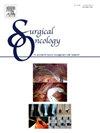胰十二指肠切除术后胰腺瘘的胰胃造口术和内镜下经胃引流术的安全和有益效果
IF 2.3
4区 医学
Q3 ONCOLOGY
引用次数: 0
摘要
目的 预防胰十二指肠切除术后胰瘘(POPF)形成的最佳手术技术和围手术期管理尚未确立。本研究探讨了胰十二指肠切除术与内镜下经胃引流术的围手术期结果。方法我们对2016年至2023年间接受胰十二指肠切除术的191例患者进行了回顾性分析。他们被分为两组:胰空肠吻合术组(n = 135)和胰胃造瘘术组(n = 56)。我们比较了术前因素和术后结果。结果 两组患者的术前因素相似。胰胃造口术组的手术时间[480(404-542)分钟 vs. 382(346-458)分钟]、失血量[505(270-850)克 vs. 315(145-535)克]、假性动脉瘤形成(7% vs. 0%)和术后住院时间[28(22-38)天 vs. 19(17-24)天]均显著低于胰胃造口术组。在对 41 名 POPF 患者的分析中,胰胃造口术组的术后住院时间[40 (23-108) 天 vs. 27 (18-54) 天]和确诊 POPF 后的住院时间[30 (10-99) 天 vs. 15 (5-35) 天]明显较短。胰胃造口术组 77% 的患者进行了内镜下经胃引流,所有患者都成功完成了引流。本文章由计算机程序翻译,如有差异,请以英文原文为准。
Safe and beneficial outcomes of pancreaticogastrostomy with endoscopic transgastric drainage for pancreatic fistula after pancreaticoduodenectomy
Purposes
The optimal surgical technique and perioperative management to prevent postoperative pancreatic fistula (POPF) formation after pancreaticoduodenectomy have not yet been established. This study examined the perioperative outcomes of pancreaticogastrostomy with endoscopic transgastric drainage.
Methods
We performed a retrospective analysis of 191 patients who underwent pancreaticoduodenectomy between 2016 and 2023. They were divided into two groups: pancreaticojejunostomy group (n = 135) and pancreaticogastrostomy group (n = 56). We compared preoperative factors and postoperative outcomes. We performed endoscopic drainage only in the pancreaticogastrostomy group.
Results
Preoperative factors were similar between the two groups. Operative time [480 (404–542) vs. 382 (346–458) minutes], blood loss [505 (270–850) vs. 315 (145–535) g], pseudoaneurysm formation (7 % vs. 0 %), and postoperative hospital stay [28 (22–38) vs. 19 (17–24) days] were significantly lower in the pancreaticogastrostomy group. In the analysis of 41 patients with POPF, postoperative hospital stay [40 (23–108) vs. 27 (18–54) days] and hospital stay after POPF diagnosis [30 (10–99) vs. 15 (5–35) days] were significantly shorter in the pancreaticogastrostomy group. Endoscopic transgastric drainage was performed in 77 % of patients in the pancreaticogastrostomy group, and drainage was successfully completed in all patients.
Conclusion
Pancreaticogastrostomy with endoscopic transgastric drainage could be effective for the safe management of pancreaticoduodenectomy.
求助全文
通过发布文献求助,成功后即可免费获取论文全文。
去求助
来源期刊

Surgical Oncology-Oxford
医学-外科
CiteScore
4.50
自引率
0.00%
发文量
169
审稿时长
38 days
期刊介绍:
Surgical Oncology is a peer reviewed journal publishing review articles that contribute to the advancement of knowledge in surgical oncology and related fields of interest. Articles represent a spectrum of current technology in oncology research as well as those concerning clinical trials, surgical technique, methods of investigation and patient evaluation. Surgical Oncology publishes comprehensive Reviews that examine individual topics in considerable detail, in addition to editorials and commentaries which focus on selected papers. The journal also publishes special issues which explore topics of interest to surgical oncologists in great detail - outlining recent advancements and providing readers with the most up to date information.
 求助内容:
求助内容: 应助结果提醒方式:
应助结果提醒方式:


